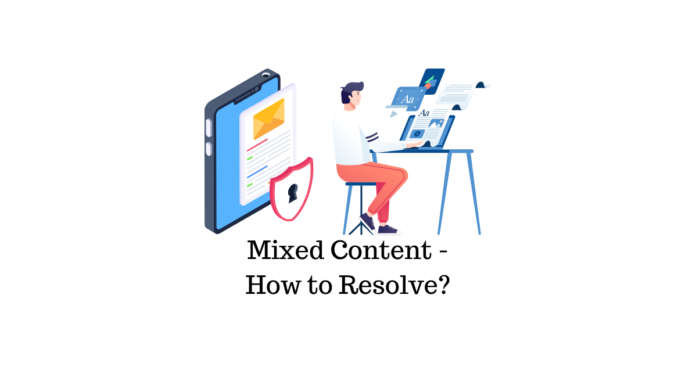If any of the following situations happen on your website, you probably have problems with mixed content.
- A yellow triangle shows on the right side of your URL bar
- Users get notifications that your website isn’t fully secure
- There is no green lock next to the URL bar
Mixed content problems happen because of the incorrect HTTPS and SSL settings. In this case, the web browser is loading content or pages that are both HTTPS and HTTP simultaneously. This means that these pages are only partially encrypted and, therefore, somewhat safe.
Non-secure content can be attacked even though it is served over HTTP. And this also affects visitors to your site. When visitors reach a website that isn’t safe, they can react in two ways:
- They can ignore the warning and continue browsing, which can be bad for them
- The second option (and the worst one) is if they leave your website and never return because they assume your website is unsafe and unreliable.
Why does this happen in the first place?
When you migrate your website to HTTPS, everything should be running over that protocol, including images, Javascripts, files, etc. If there is HTTP content on the webpage, users will see the content, but your site won’t have a green lock – a symbol that shows that your page is safe and reliable.
Here are the most common reasons mixed content problems happen:
- Most of these problems occur when you migrate your webpage to HTTPS, and some HTTP files get carried over automatically.
- If you add a new plugin on service to your webpage via absolute paths instead of relative paths – mixed content problems can happen.
- Images have hardcoded URLs on pages, widgets that are HTTP
- External embedded videos are HTTP instead of HTTPS
- Your website is linking to external HTTP sources
Mixed content errors can also happen if you have an SSL plugin that is not set up correctly. SSL is an excellent addition to your website and can prevent mixed content errors. But if the SSL is not working correctly, the plugin won’t be able to detect your HTTP content and therefore avoid any further problems.


Why is mixed content dangerous?
These are some of the reasons:
- Hackers can attack your website and change any piece of the content on it
- Passwords, cookies, or any data can leak and land in the hands of criminals
- Visitors can be redirected to other sites without their knowledge
- Visitors will lose trust in your brand and site
- Your content will be marked unsafe and rank lower in Google search results.
- Visitors will leave your site if they see it isn’t safe. What is even worse, they are unlikely to come back.
Why you should resolve this?
Three primary benefits you get if you resolve the issues of mixed content errors are:
- Authentication – Visitors will be assured that they are safe if browsing your site. Also, no mixed errors will show that your website isn’t malicious.
- Data integrity – You visitors will be assured that you are safe and that none of their data or personal information will leak.
- Anonymity – Your visitors will see that their identity and their behavior on your website are protected. This will suggest that none of their data will intercept.


What are the types of mixed content?
There are two types of mixed content errors – mixed passive/display content and mixed active content. The main difference is in the level of the threat website can face if the content becomes the center of the attack.
In the case of passive content, the danger is lower than compared with problems a website can have if it has active mixed content mistakes.
Mixed passive content or Passive scripting
This mixed content error happens when the content is served on HTTP and included on HTTPS. In this case, hackers can replace images on the website and track what pictures users see on the page and which page they are visiting. Loading this type of content on HTTPS can completely ruin the safety of your website.
These HTTP requests are considered passive content:
<img> (src attribute)
<audio> (src attribute)
<video> (src attribute)
<object> subresources (when an <object> performs HTTP requests)
Active content
This type of mixed content is more common but is also more dangerous. Websites prone to these problems can face issues with data leaks. In other words, if there is active mixed content on the site, potential threats include altering the users’ behavior and theft of their data.
When the active content type of error happens, attackers can interrupt the request for HTTP content, rewrite the code, and include malicious code. This will allow attackers to steal users’ login information, obtain sensitive data or even install malicious software on the users’ system.
The degree of harm usually depends on the type of data. If the data on the website is public without any sensitive information, the active mixed content error still can cause problems. Some of them are the theft of the HTTP cookies or redirection to another HTTP page.
These are the most common active mixed content errors:
<script> (src attribute)
<link> (href attribute) (this includes CSS stylesheets)
<iframe> (src attribute)
XMLHttpRequest requests
fetch() requests
All cases in CSS where a URL() value is used (@font-face, cursor, background-image, and so forth).
<object> (data attribute)
Navigator.sendBeacon (url attribute)
How to resolve mixed content issues?
The easiest way to resolve this issue is to install the SSL plugin. This will add a layer of security to your website. Also, since 2018, having SSL installed on your website has affected your ranking in Google searches.
SSL actually ensures the safe transfer of data, its correlation to a proper server, and its integrity. Every website should have SSL installed because this plugin affects visitors’ trust. When you install SSL on your website, you show your customers that they can trust your business.
What is the best SSL to use and prevent mixed content problems?
If you want to install the plugin that will easily and simply resolve any issues with mixed content errors on your page, we recommend WP Force SSL.
For starters, this plugin includes tools for other plugins and themes. WP Force SSL is easy to use because it was developed for individuals with no technical or coding skills, it automatically generates SSL for you, so no coding is required – the only thing you need to do is install SSL on your website, which is easy. To read more about it check this site.
In conclusion
WordPress’ mixed content error isn’t as bad as it sounds if you or your users are encountering it. It’s really one of the simplest WordPress errors to repair. With the help of a simple plugin, you can easily remove the mixed content problem from your website in a matter of minutes.











